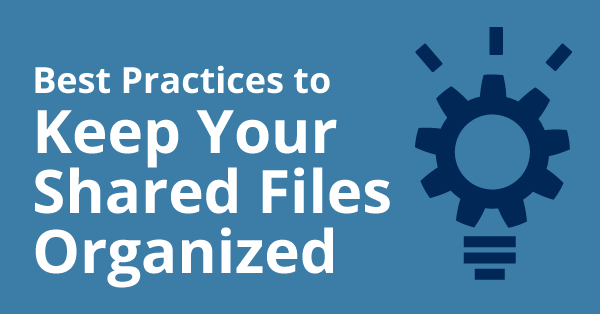Be honest. You know you’ve done it… You downloaded a document you needed for a project, but instead of sending it to the right folder, you let it default into “Downloads.”
Now you need it, and it’s buried among the many other files you also downloaded and didn’t properly store. You’re wasting time trying to find it when you could have saved yourself the trouble from the very start.

Consistent, organized file storage across your whole organization is vital to your business’s success. Your employees need to be able to easily save and find the files they need, so they can be as efficient as possible. Technology has made file sharing easier, but, if you aren’t following best practices, storing and sharing files online can create IT security risks and lost productivity.
Here are ways to set up and manage your digital file organization, helping to ensure your business is following best practices for shared files.
What Are the Best Practices for Shared Files?
Sharing files both inside and outside your business is critical for your daily operations. There are three goals to keep in mind when it comes to organizing your shared files.
- Make storing files easy
- Make finding files easy
- Make the process repeatable
Here are some tips to help you achieve these digital file management goals.
Shared Files Best Practice #1: Build a Well-Planned Folder Structure
Especially when collaborating with others, structuring your shared files in folders is important for making it easy to find and organize files.
- Your shared files should be organized based on the way you work.
- Define your top-level folders such as projects, clients, and departments. You don’t want to add to this level often. Minimizing the number of folders makes it easy to hone in on what you need.
- Use subfolders to add another filter for finding what you need. It may be helpful to use a “template” of subfolders to use throughout the structure. For example, you can simplify organization with “final”, “draft”, and “archive” folders. Hint: You can also group files by format like PDF or JPEG.

Shared Files Best Practice #2: Name Files & Folders Based on Search Intent
It’s important to have a standard naming convention to build consistency, keeping your shared files organized ongoing. But, you’ll want names that are meaningful to everyone.
- Think about how you would look for the files. What best describes the folders contents and how does it relate to others? Would you need to look for it by date?
- Be concise. The best file names are usually short and sweet.
- Metadata is your friend. Keywords, tags, and descriptions will come in handy when you’re sorting through hundreds or thousands of files.
Remember when we said consistency matters? Collaboration is more difficult when everyone comes up with individual file systems. You can ensure consistency across the organization by providing guidelines—then make sure it is followed by all.
- Set up a time to go through your shared files & folders and remove what’s no longer needed—whether it be weekly, monthly, or quarterly. Hint: You can archive stale data to make a visual check much easier!
- Get feedback from your employees to make sure your file system is work for you. Are they able to easily find what they need? Do they know where to store shared files?
Shared Files Best Practice #3: Back Up Everything
It’s a common misconception that cloud storage is the same as cloud backup, or that cloud storage doesn’t require a backup. Cloud backups make regular copies of your files and offer an easy way to restore your files. And, cloud file-sharing services like Microsoft 365 recommend having a 3rd party backup to protect your files.
- Set up automatic and regular backups to the cloud. And then, periodically, check to make sure the backups work.
- Make sure your backup solution covers all files. For example, some Microsoft 365 backup services only protect your email and shared files in OneDrive. If you’re using Microsoft Teams or apps like Planner, you’ll want a more inclusive backup service!
Learn more about Microsoft 365 backups here.
What are some employee-friendly tips for keeping shared files organized?
- Don’t store anything on your computer. Instead, live in the cloud. It’s easiest to get in the habit of saving to the cloud as you go by using the “Save As” option after creating or downloading a document.
- Use the desktop sync for any commonly used folders. This will keep your shared files in the cloud while giving you easy access from your computer (instead of in the browser).
- Share a link instead of sending an email attachment. It helps keep everyone working in the same place. With OneDrive for Business and Microsoft Teams, you can share directly from the document or you can select to “copy a link” that you can provide people.
- Save your email attachments to OneDrive from Outlook. If you receive important shared files via email, you can easily save to the cloud with one click. Hint: you can save all attachments sent to your email to OneDrive for Business by setting up a workflow with Microsoft Flow.
- Use @mentions to tag collaborators in documents to drive action. You can even have a conversation with everyone who has access to a document. With any Word document in Teams, just select the “Start a Conversation” tab to open a right sidebar chat.

Best Practices for Digital File Organization (Plus End-User Tips)
Now you know the best practices for digitally organizing your shared files to ensure your employees are efficient and productive.
To recap, here are the cardinal rules:
- Build a well-planned folder structure
- Name Files & Folders Based on Search Intent
- Document the Process & Follow It
- Back up everything


